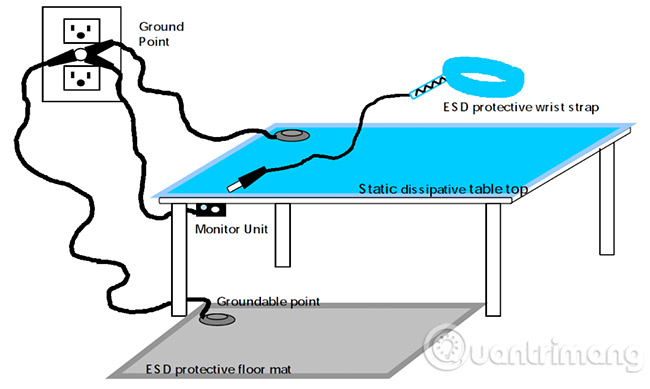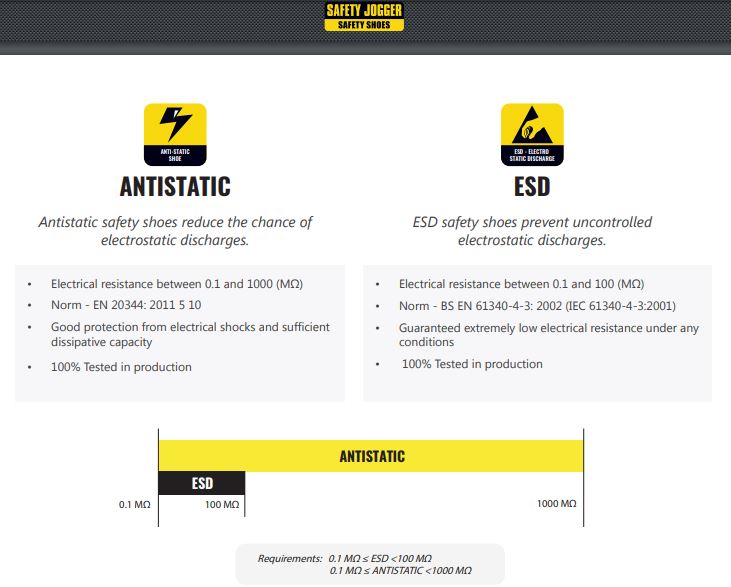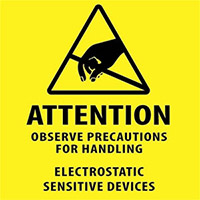Tĩnh điện là gì
Tĩnh điện là hiện tượng mất cân bằng điện tích trên bề mặt của một vật liệu. Điện tích sẽ được lưu giữ ở đó cho đến khi nó có thể truyền đi nơi khác thông qua một dòng điện hoặc sự phóng điện.
Đang xem : Electrostatic là gì
Static is generated when two objects made of different electrically neutral materials contact and then separate .

1 ) Contact between objects A and B
Electrically neutral objects A and B ( with equal quantities of positive and negative charges )
2 ) Transfer of charge
When metals contact each other, electrons move from one with a smaller work function to one with a larger work function. In other words, metal with a smaller work function will be charged positively and one with a larger work function negatively .
3 ) Separation between objects A and B
Object A is charged negatively and object B positively .
Figure 1. Static generation due to contact charging
Static is generated when two objects contact and then separate. The combination of the two objects may be solid and solid, solid and liquid, or liquid and liquid. Figure 2 shows examples .

Figure 2. Examples of static generation
All the above phenomena involve contact between two objects and their separation .
Figure 3. Examples of charging
Friction between two objects in a triboelectric series causes the object in the upper position of the series to be charged positively and that in the lower position to be charged negatively. Friction between two objects positioned far apart ( C ) also generates a larger amount of static than ones closer to each other ( B ) and much closer to each other ( A ) ( A
When an object is charged
When an object is charged electrostatically, an electrical field is generated around the charged object, as illustrated in Figure 4 .

Figure 4. Electrical field generated around charged objects
An electrical field is a space in which an electric charge induces its electric force ( Coulomb force ) to work. An electrical field that does not change over time or spatially is called an electrostatic field. The number of lines of electric force that pass a unit area of a certain point ( density of lines ) indicates the strength of the electrical field, while the tangential direction of the lines of electric force on the point indicates the direction of the electrical field. The line of electric force also has the following characteristics .
Starts from a positive electric charge and ends in a negative electric chargeLines do not intersect each otherDoes not branch offThe electrical field is strong when lines of electric force are denseThe electrical field is uniform when lines of electric force are parallelComes out of ( enters into ) the surface of a conductor vertically
Figure 5 shows an example of lines of electric force formed between two charged objects .
Xem thêm : Con Số May Mắn Ngày 20 Tháng 2 Năm 2021, Con Số May Mắn Hôm Nay 3/3/2021 Của 12 Con Giáp
( a ) Lines of electric force between objects with different electrical polarities
( b ) Lines of electric force between objects with the same electrical polarity
Figure 5. Lines of electric force formed between two charged objects
Lines of electric force are virtual lines used to visualize an electrical field. Their use shows the state of an electrical field formed between two charged objects, making it easy to picture the state of static, which is actually invisible. For example, Figure 6 shows lines of electric force between two objects with different quantities of electric charge. It shows lines of electric force that apply to a case where the quantity of electric charge Q1 of charged object A is smaller than the quantity of electric charge Q2 of charged object B. Because the size of the two charged objects is the same, the number of lines of electric force per unit surface area of charged object A is smaller than that of charged object B, and electrical field E2 is stronger than E1 .
E1 : Strength of electrical field on a conductor surface
Density of lines of electric force : Low à Electrical field is weak
Charged conductive sphere A
E2 : Strength of electrical field on a conductor surface

Density of lines of electric force : High à Electrical field is strong
Charged conductive sphere B
Figure 6. Lines of electric force from two charged conductors with different quantities of electric charge
What is electrostatic force (Coulomb force)?
Electrostatic force ( Coulomb force ) is the source of an electrostatic phenomenon. As Figure 7 shows, the direction of the force between two charged objects differs according to whether the objects have different electrical polarities or the same electrical polarity. Electrostatic force is an attractive force ( a ) when the polarities are different and a repulsive force ( b ) when the two objects have the same electrical polarity .
( a ) Force between objects with different electrical polarities

( b ) Force between objects with the same electrical polarity
Figure 7. Electrostatic force between two charged objects
As Formula ( 1 ) shows, the strength of the electrostatic force ( Coulomb force ) is proportional to the product of the quantities of the electric charge of the two charged objects and inversely proportional to the square of the distance between the two objects .
F ∝ Q1 ・ Q2 / r2 ・ ・ ・ ・ ・ ・ ・ ・ ・ ・ ・ ・ ( 1 )
Electrostatic induction is also caused by electrostatic force
Figure 8. Electrostatic induction caused by electrostatic force
Electrostatic discharge is also caused by electrostatic force (Coulomb force)

Figure 9. Generation of electrostatic discharge caused by electrostatic force
The electrical field around the charged object causes the negative ions ( electrons ) therein to be accelerated by the electrostatic force ( Coulomb force ), thereby having kinetic energy ( wv ). When these negative ions strike gas molecules in the electrical field and the following formula is true ,
Ionization energy of the gas molecules
electrons are sputtered from the gas molecules, resulting in generation of negative ions and positive ions. The gas molecules are ionized if the negative ions thus generated are subject to action of the electrostatic force and the negative ions are accelerated in the electrical field with its kinetic energy meeting the condition expressed in formula ( 2 ) above. Repetition of this process results in generation of electrostatic discharge .
Charge distribution of a conductor is also influenced by electrostatic force (Coulomb force)
1 ) Electric charges given to an electrically neutral conductor are distributed on the conductor’s surface. In other words, electric charges given do not exist inside the conductor. Suppose that a conductor is given four negative electric charges, thereby charged negatively, as Figure 10 shows. If the four charges are given inside conductor ( a ), electrostatic force ( repulsive force ) works among them, forcing them to be distributed on the conductor surface .
Figure 10. Distribution of electric charges on a charged conductive sphere
2 ) As explained in the previous section, electric charges given to an electrically neutral conductor are distributed on the conductor’s surface. Thes e charges are distributed in a way that the surface will be equipotential. In other words, the charges given will not exist inside the conductor. Charges on a conductor are distributed in such a way that the surface will be equipotential .

( a ) Conductor with surface potential distribution
If a conductor surface has potential distribution ( a ), a potential gradient ( electrical field Ex ) is generated along the surface. Ex causes the electric charges on the conductor surface to move along the surface to a part with low potential, thereby heightening the potential of the part. This movement of electric charges continues until the surface becomes equipotential. As a result, the electrical field that comes out of ( enters via ) the surface of the conductor is vertical to the surface ( b ) .
Xem thêm: Open Dns Là Gì Đến Bảo Mật Hoặc Tốc Độ Chơi Trò Chơi Không? Dns Là Gì, Sử Dụng Thế Nào
( b ) Electric charges that are distributed in a way that makes the conductor surface equipotential
Figure 11. Electric charges are distributed on a conductor surface in a way that makes the surface equipotential .
